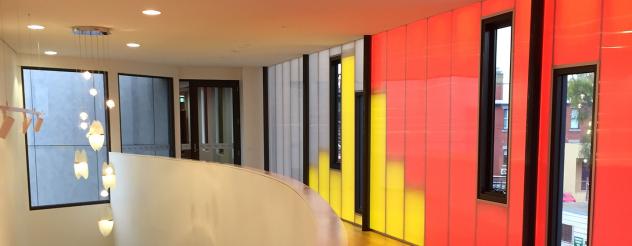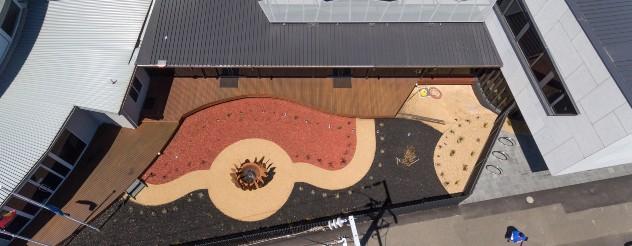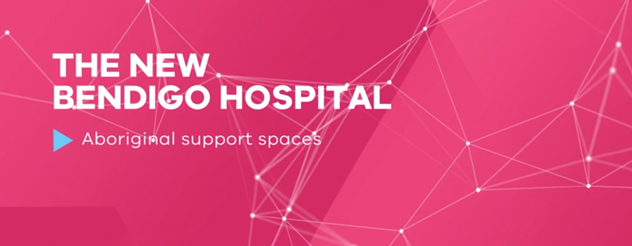
- Home
- News and events
- Celebrating International Day of the World’s Indigenous Peoples 2020
Celebrating International Day of the World’s Indigenous Peoples 2020
Please note: As of 1 February 2021, the Victorian Health and Human Services Building Authority (VHHSBA) became the Victorian Health Building Authority (VHBA).
The United Nations' International Day of the World’s Indigenous Peoples is observed on 9 August each year to promote and protect the rights of the world's indigenous population.
It's an opportunity to celebrate the achievements and contributions that indigenous peoples make to improve world issues such as environment protection.
The theme of this year's International Day is 'COVID-19 and indigenous peoples' resilience'. The theme of tackling health challenges, and promoting wellbeing and resilience, is embedded in the work of the Ballarat and District Aboriginal Co-operative (BADAC).
The Ballarat and District Aboriginal Co-operative was formed in 1979. It has continued to deliver health, social, welfare and community development programs to local Aboriginal people in the ensuing four decades to the Ballarat area and surrounds.
The Ballarat and District Aboriginal Co-operative Medical and Regional Health Hub was officially opened in November 2019. The hub incorporates art and design features that reflect authentic indigenous culture, creating a safe and welcoming space for the local community.
Learn more about the Ballarat and District Aboriginal Co-operative Medical and Regional Health Hub and the Regional Health Infrastructure Fund via our dedicated pages.
Watch and listen to hear how indigenous culture and design were incorporated into the Ballarat and District Aboriginal Co-operative Medical and Regional Health Hub.
Video transcript
TEXT: The Victorian Government partnered with the Ballarat and District Aboriginal Co-operative, contributing $6m from the Regional Health Infrastructure Fund towards their new health hub.The new hub was opened in 2019. It incorporates art and design features that reflect authentic indigenous culture, creating a safe and welcoming space for the community it serves.
IMAGES: An aerial shot looking down on an indigenous designed garden area. We see the corner of the new facility, revealing a kangaroo shaped window design. Then a view along the back wall of the facility, using Aboriginal flag colours. We see inside a corridor using translucent sheets featuring Aboriginal flag colours.
TEXT: Karen Heap CEO BADAC (Yorta Yorta).
Karen Heap: I was really trying to make sure that we incorporate culture and the land and those sorts of things into the building, because that’s what’s important to us.
IMAGES: Montage of features using indigenous design, including light fitting, artworks.
TEXT: Jon Kanoa COO BADAC (Kerrupmara/Bunitj).
IMAGES: Chief Operating Officer Jon Kanoa talking to camera.
Jon Kanoa: Any new infrastructure that we're looking at we make sure that we have a cultural feel, to make sure that the community feel comfortable coming through our doors.
IMAGES: Aerial view of the Ballarat township.
TEXT: Alan Morton Director, Morton Dunn Architects.
IMAGES: Architect Alan Morton talking to camera.
Alan Morton: A respect for people, a respect for the environment and a respect for country. As architects we see that as very strong within our ethos as well, so the connection is really pretty seamless.
IMAGES: Montage of curving design features.
Karen Heap: I like to have a better shape to things so that was very important to me.
Alan Morton: Recognising it is a medical facility but trying to make it really as least clinical as possible.
IMAGES: Montage of staff and community members in the facility.
TEXT: The translucent flag.
IMAGES: We see the translucent wall featuring Aboriginal flag colours. We then see inside a corridor using translucent sheets featuring Aboriginal flag colours.
Karen Heap: I love this! I think that was a real catch on our part because it was just going to be red. I was talking to the site supervisor and he said "there’s other colours" and that and I thought "oh, well let's get the other colours and make the flag."
IMAGES: Chief Financial Officer Leigh Skelton talks to camera.
TEXT: Leigh Skelton CFO BADAC.
Leigh Skelton: We really did try to involve the community as much as possible.
Jon Kanoa: The more that they've got a voice, and the more that their ideas are actually seen in the organisation gives them a form of ownership of the building as well.
IMAGES: We see detail of the fire pit. Jon Kanoa talks to the camera. We are shown wall art featuring traditional Aboriginal designs.
TEXT: Di McLeod BADAC community member.
IMAGES: Community member Di McLeod talks to the camera.
Di McLeod: I've got some art in the social and emotional wellbeing rooms. I've done the lamps – that gives you a sense of belonging. You just belong here.
IMAGES: Di's art works are shown.
TEXT: Wathaurong glass.
IMAGES: Leigh Skelton talks to the camera.
Leigh Skelton: The light that’s behind me right now is a design between Karen and the community they came up with.
IMAGES: Detail of the Wathaurong glass chandeliers is shown.
TEXT: Nikki Bell Senior Youth Engagement Worker (Gunditjmara).
IMAGES: Senior Youth Engagement Worker Nikki Bell talks to the camera.
Nikki Bell: They're an Aboriginal company that make the glass from the Wathaurong land. The kids that I work with they'll always ask "Oh, what's that?". And you have to explain that this is Wathaurong land and that's what the glass is made from.
TEXT: Jason Kanoa Youth Engagement Worker (Kerrupmara/Bunitj).
IMAGES: Youth Engagement Worker Jason Kanoa talks to the camera.
Jason Kanoa: Coming here with stuff like that makes them feel a little bit more comfortable. The people that come here feel like this is our place.
IMAGES: A community member walks down the long curved staircase. Jon Kanoa talks to the camera.
Jon Kanoa: They feel that the environment is culturally safe, culturally inclusive and making sure that whatever appointment they’re coming in for that they're feeling comfortable in doing so.
IMAGES: A group of women practise traditional weaving techniques.
TEXT: Platypus.
IMAGES: Karen Heap talks to the camera.
Karen Heap: We thought that the platypus would be a good logo for Ballarat because we are made up of different tribal groupings across the nation.
IMAGES: We are shown the BADAC platypus logo.
TEXT: Di McLeod BADAC community member.
IMAGES: Di McLeod talks to the camera.
Di McLeod: So we all feel included within this space. It’s not just one mob, we’re all a part of it.
IMAGES: Detail of fire pit with platypus design.
TEXT: Heather Hardy BADAC community member.
IMAGES: Community member Heather Hardy talks to the camera.
Heather Hardy: They were my husband's totem. Every time I look at them I see him. Both his parents were from Tasmania, but like many people they were relocated.
IMAGES: Di McLeod talks to the camera.
Di McLeod: People from WA, you know, from Alice Springs who’ve made a life here.
TEXT: Ann Patmore BADAC community member.
IMAGES: Community member Ann Patmore talks to the camera.
Ann Patmore: Everyone wants to see a platypus. Everyone wants to be friends to a platypus. They're so tiny!
TEXT: Fire pit and garden.
IMAGES: Jon Kanoa talks to the camera.
Jon Kanoa: I think that fire pit out the front is another symbol of making sure we can create a traditional sense of community and country in the middle of Ballarat.
IMAGES: Aerial view of the garden and fire pit.
TEXT: Leah Keegan Manager, Koori Family Support Services (Kerrupmara/Bunitj).
IMAGES: Leah Keegan talks to the camera.
Leah Keegan: It's always something that's been used in our culture that incorporates the whole of the community and so I look at that as something really significant.
IMAGES: Karen Heap talks to the camera.
Karen Heap: Cleansing the soul and just cleansing yourself before you go into a meeting. Having a bit of an open mind, all that sort of stuff.
Leah Keegan: Helping us on our journeys from old to new, new beginnings.
IMAGES: Images of a smoking ceremony at the fire pit.
TEXT: The Tree Room.
IMAGES: Karen Heap talks to the camera.
Karen Heap: It's a bit of nature inside, and we call that room the Tree Room now. I think it's brilliant.
IMAGES: Jon Kanoa talking to the camera.
Jon Kanoa: The branches of the tree symbolises where we are as a community. We were built off the foundations of the Stolen Generation. You've got your roots and your foundations of where BADAC's come from, to the tree to the families that sort of branch out, and it makes sure we're all still connected in one sense.
IMAGES: Montage of tree-like design across wall and ceiling of room. Jon Kanoa talks to the camera.
Jon Kanoa: I think that having these elders and respected persons around the room as well really puts the icing on the cake for me. Y'know a lot of these people have not just impacted this community but myself.
IMAGES: Photos of elders and respected persons past and present around the Tree Room. We are shown the Aboriginal and Torres Strait islander flags.
Jon Kanoa: Knowing that we’ve got the spirit of our ancestors but also the spirit of these guys around us today, and a lot of them still with us today, just utilising their knowledge and expertise for us to move forward, but also acknowledge where we’ve come from in the past as well. I grew up with all these people around me. For me to be in the position I'm in at the moment has been influenced by each and every one of these people in this room. Wherever I need to get my strength from, y'know I’ll come in here and look around the room and hopefully I can be seen by younger generations in the way I’m looking at my elders and respected persons around the room too. It’s really personal for me.
IMAGES: The screen transitions to blue. We see the Victorian Health and Human Services Building Authority logo, the web address vhhsba.vic.gov.au and the Victoria State Government logo.
End of transcript.
Related content

15 June 2020
Ballarat and District Aboriginal Co-operative Medical and Regional Health H...
The Victorian Government contributed $6 million to deliver the new Ballarat and District Aboriginal Co-operative Medical and Regional Health Hub.
10 July 2019
Ballarat and District Aboriginal Co-operative welcomes first patients into ...
The new dedicated stand-alone medical clinic and district health hub has welcomed its first patients and is bringing communities in western Victoria together.
09 October 2018



